[leadplayer_vid id="58B33CE6847AD"]
We had fun, and bought a couple of different kinds of fish. Although, we were hoping to find a tuna that day, but no luck.
We love tuna, but it isn't popular here. Which is great for us. It is not popular so they sell it for only 60 cents a pound. Lightly seared and served with wasabi it is delectable.
Maybe next time they will have some tuna.
Where do you buy your fish in Panama?
We like to buy it off the boats. But people will walk or bike around with fish for sale.
We are alittle leary of buying non-iced seafood.
But if you go that route, here is a video that explains how to tell if a fish is fresh.
It is done by one of the YouTubers my daughter Blaise likes, Bart's Fish Tales. He also has alot of receipes for seafood of all sorts.
[leadplayer_vid id="58B33FE64858B"]
Please comment below
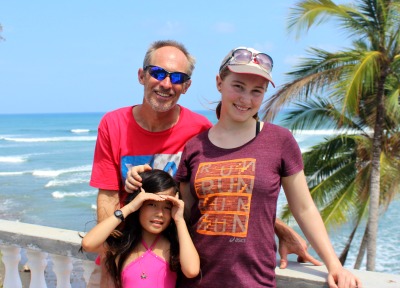
We were on our way to visit our friend Juancho at Mono Feliz.
Shawn and Shena were just putting the final touches on their surf/stand up paddle board camp.
It was spectacular. Shawn was out paddle boarding when we arrived. Shena was hanging out with their 2 kids.
We ended up staying for much longer than we intended. It was a very comfortable place and we all had a great time sitting around and chatting.
The aerial video below was taken of and around Burica Surf. It was taken before our visit. As you will see the main building is still under construction. The water and conditions look sweet.
[leadplayer_vid id="588EA3DE25B69"]
You can find various wave opportunities for both beginning and advanced surfers, as well as for beginning and expert stand up paddle (SUP) boarders. You can rent a board at Burica Surf for $20/day.
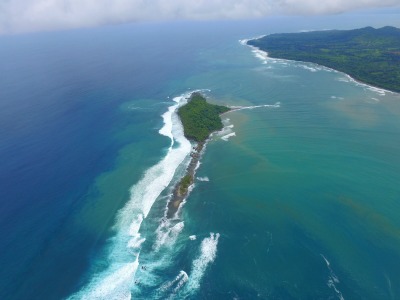
You can also paddle out to Burica Island (or Isla Burica) in about 25 minutes. It can be leisurely circumnavigated in an afternoon.
My husband has enjoyed surfing at Burica Island before and wrote about it.
Burica surf is at the very tip of Punta Burica. It is in a remote area with views of Burica island.
It is about a 1-1/2 hour drive from the beach town of Puerto Armuelles.
From Puerto Armuelles, every hour there are small buses to the village of Bella Vista. (These buses stop after 6pm.) Bella Vista is about 2.5 kilometers from Burica Surf. Which means it will take you about 30 minutes on foot or 15 minutes by car to get to Burica Surf from Bella Vista.
If you want, you can ask the Burica Surf folk to come and pick you up at the airport in David or in Paso Canoas. Paso Canoas is the town at the border between Panama and Costa Rica.
For detailed directions to get to Punta Burica & Burica Surf, visit our Punta Burica hotels page.
Now the accommodations are even nicer than when we visited. Check out the photo below of their main building. I downloaded it off their website, buricasurf.com.
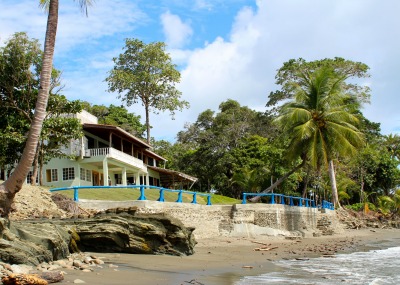
Rooms
Lodgings at Burica Surf are rustic, yet comfortable.
There is no electricity or Internet. Which means it really is a wonderful nature retreat without distractions.
They have 4 rooms and 3 dorms.

Food
Meals are available for purchase. It is only $30 a day (3 meals).
All meals are served in a “family” style in the upstairs dining area overlooking the surf breaks.
To reserve your accommodations, you must pay a 50% deposit.
You can cancel your reservation within 24 hours of booking your accommodations.
They offer group rate and package deals.
Electronic bank transfer, Pay Pal, and cash (USD).
You are welcome to show up without a reservation, but then they can only accept a cash payment. (Remember there is no internet or electricity at Burica Surf)
You can find out more, including their contact information, at their website: BuricaSurf.com.
If you make it out there I'm pretty sure you will have a fun and relaxing time.
As Shawn says, "There's always something to ride!"
Please let me know how you liked your visit there. Comment below.
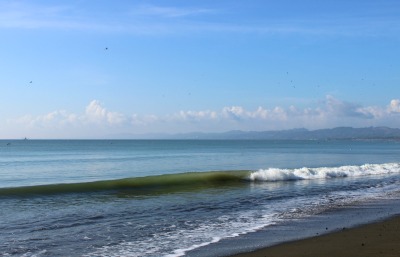
Jan. 26, 2017
On my very first morning, I went to the beach at Corazon de Jesus on for a swim.
I had been told that the November rains were heavy this year and that there was still a lot of drift wood on the beach. However, to my eyes it looked pristine and beautiful.
I had been away for over three months this trip. I had been spending my days in a very cold, grey, and rainy Seattle, so I was not aware of anything other than a perfect morning at the beach.
I was the only one out. The gentle curve of the beach was an empty crescent. Just the sand, nearly mirror flat, the early morning ocean, and I.
I took a short swim, which was plenty. (Note to self: I am really out of shape). But, man did I feel wonderful! The water was probably a warm 80 degrees, or so.
After swimming, I decided to go visit some of my neighbors on the beach.
There are several ex-pat residents in the Corazon de Jesus neighborhood. I was especially interested in talking to a couple of these folks who are doing construction on their homes using local contractors.
I enjoyed hearing about their experiences with the various contractors and sub-contractors. I will write about what I learned in a future post.
In the few days I've been back in Puerto Armuelles, I am noticed a number of new northern faces.
One woman, who had just ended a Panama relocation tour, made a special visit to Puerto. She said that she heard about Puerto Armuelles on our site, and wanted to check out for herself.
She says that she has "caught the Puerto bug". We’ll see if she decides to join us in Puerto soon.
Several of our visitors have visited Puerto more than once to “check it out” and are now expressing interest in buying. Most of our recent buyers are either from Canada or from northerly parts of the US.
A few folks have decided to rent homes in Puerto, rather than buying. Hopefully more rentals will continue to come on the market to meet this growing need for long-term rentals.
Some big news is that Del Monte may finally be coming to Puerto to start up banana production this June 2017. At least this is what the news media here tell us.
My most skeptical Panamanian neighbors here say they will only believe Del Monte is coming when they have peeled and eaten a Del Monte banana that was grown in the soils of Puerto Armuelles.
We all hope Del Monte really does come to Puerto. The town will benefit from the mostly working class jobs that Del Monte will provide.
However, as far as the arrival of ex-pats and any tourist industry here are concerned, I do not think that Del Monte will have much effect. I believe we have passed the “tipping point” and growing appeal of Puerto Armuelles to expats and Panamanians alike is certain. It is already happening.
But don’t believe me: Come visit and see for yourself. Who knows? You might “catch the Puerto bug” too.
You can learn more about Puerto Armuelles here.
[leadplayer_vid id="58506DB07FEED"]
If you are interested in visiting Mono Feliz, visit their facebook page for more information. I have also written about Mono Feliz on my site.
You can visit Mono Feliz via a road (which is soon to be paved most of the way) or, my favorite way, by driving on the beach. You must time your journey with the tides.
We have visited Mono Feliz from Puerto Armuelles both as a day trip and for multiple nights.
You can learn more about Puerto Armuelles starting here.
Betsy: Hi, it was a lot of fun stumbling across this video is of us back in 2007.
It gives you a relaxing glimpse of life in Panama
It's a little baby monkey, she's 4 months old,called Niña, a howler monkey.
We're at Mono Feliz in Panama, Punta Burica.
Reyn: We're relaxing and the stresses of daily life.
Our house is actually being sprayed for termites,as we speak, so we had to vacate it for the weekend.
They sprayed it with a mix of diesel and ariva, which is a commercial crop dusting chemical, so that's all going in our house so it'd be nice to let it air out for the entire weekend before we go home and sleep there.
We're here at Mono Feliz,there are small waves at the surf camp down the way
and Steve and another tourist and I were gonna try those out, so that will be fun.
Skylar: Look, look dad.
Reyn: I'm very happy and relaxed here.
It's cool.
(child laughs)
I think the monkey can actually hang by his tail.
Betsy: He's too young.
Reyn: This one is a huérfano.
Betsy: Let's say goodbye to Niña.
Bye, bye Niña, little scratcher.
Reyn: Want to compare size of hand?
music ♫ Can you hear it calling, Come on down to Panama
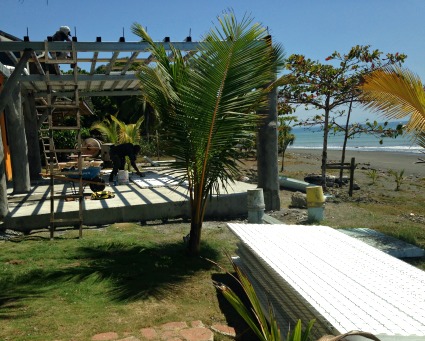
Given that, I was surprised that one of my favorite things to do as we traveled around Panama was to stop by construction sites and talk with other builders. I had fled the hustle and bustle of the building trade in Seattle only to discover, once again, how much I enjoy the fundamental beauty of human “dwellings” and how they are built. Apparently I made a good choice when I chose to become a designer/builder.
It doesn’t take long for one builder, chatting with another builder, in a new area, before the conversation winds its way around to the cost of materials, the cost of labor, the cost of land, to arrive at the potential profitability of being a builder in this new location.
Although I always prided myself on being more of an artisan design/builder than just a financially-motivated contractor, the profit potential in Panama is very seductive.
Early in our Panama travels we met a young builder and his girlfriend at Playa Cambutal. Playa Cambutal is out on the Azuero Peninsula, past Pedasi and Tonosi. They were both surfers and they loved this beautiful surf spot. The young man had borrowed $30,000 (as I recall) from his father who was a realtor somewhere in California. With this money, he and his girlfriend were able to buy a number of oceanfront farms, totaling over 2 miles of beachfront. Amazing!
We all know stories like this, and at first glance, one might say, “Wow! You guys are lucky. I guess we got here too late.” I remember my Dad telling stories about the farm he could have bought in Northern Virginia, a farm that later became Tyson’s Corner Mall.
There have always been great deals. And there will always be great deals. And we are all going to die some day. We still see amazing land deals in Panama.
About 10 years ago we spent some time investigating Pedasi and Tonosi, and other nearby locations. Yes, we discovered some amazing land deals. However, we decided that we were not interested in living so remotely, so far from services. And we had no interest in traveling to check in on any land we would buy in such a remote location.
This young couple (above) explained to us that they had to spend several hours, twice a week, driving to a small town, about 40 miles away, to do their basic shopping. For our own family, spending so many hours on the road, just sitting in the car, and burning gasoline, would not have fit our desired lifestyle. This was the in-the-car lifestyle we were trying to avoid by moving from Seattle. So we left the Azuero Peninsula and chose to live and invest in Puerto Armuelles. If you have read our site much, you will know we are very happy with our decision.
When I am asked if there are any “deals” left in Puerto Armuelles, I have to chuckle.
In truth, the big speculator class of investors arrived in Puerto 12 or 13 years ago. We got here 3 years after the miles of beachfront were sold to speculators from out of town. These same early investors continue to sit on some of the largest tracts of beachfront property in our area. I have no idea how they spend their days. But I am sure that they hardly ever think about our little beach town, unless they are looking at their investment portfolios.
A couple of these “big fish” are now offering schematic drawings of their future plans for these properties, but they haven't started to build yet. Or seemingly will in the near future. Meanwhile, a smaller class of builders, folks like us, is beginning to develop and build.
Yes, there are deals still to be had here. But you will not find the best deals advertised on the internet. You will find them by being here in Puerto.
You need to look around. Decide on your favorite locations and start talking with people. You will start to hear about some stellar deals.
For instance, if you shop, you can still pick up a house, a block from the water, for only $11,000 and a buildable lot for as low as 3 to $5,000.
Puerto Armuelles is a beach town of 25,000 residents, give or take.
It has many good properties and existing buildings, that with a skillful touch can still be resold for a substantial profit.
We want to encourage designers and builders to come check out Puerto Armuelles. To discover if there are any potential projects that suit them in our town. If so, not only will you have a great project, but you can step out of the stressful lifestyle of being a builder, contractor, or designer up north.
If you have experience in alternative energy housing, cooling, and transportation, even better. That is an untapped market here.
There is plenty of room for competitors in our market. Puerto Armuelles does have a few good builders, but we definitely need more motivated and skilled investor builders to provide housing for the growing influx of expat retirees. More good builders will just bring a greater diversity of expats and Panamanians to enjoy the lifestyle that Puerto has to offer.
Small-scale projects are definitely in demand. We recently sold a couple of our own projects. We did not make ten, or even five times our initial investment, but we have done well enough to carry us forward. Plus we have had a good family adventure and enjoyed our time doing it. And we have also slowly evolved our guiding design principles for building in our area. We are eager to continue to buy, to build and to sell.
We are excited by the uptick in the housing sales market. This enables us and others to design and build in a manner that inspires us, and that we think will be useful to new expat residents of Puerto Armuelles.
Our friend Victor describes life in Puerto Armuelles as being similar to that of Hawaii, or Southern California of 50 years ago.
You may find Puerto Armuelles is a more relaxed, and probably a more profitable building environment. And you won't have the stiff competition from other builders.
The broadest market niche by far available to expats in the construction field is that of “investor/builder”. You don't need a work permit to work on your own property, even if your intent is to sell it.
However, for the last few years, Panama has made getting a work permit much easier. This is especially true if you obtain the easy-to-get, Friendly Nations visa. That permanent resident visa was designed as a stepping stone to a work permit.
If you are a builder looking for a change in lifestyle, we invite you to check out our town.
For the builder who loves a beach town lifestyle, I would say that Puerto Armuelles is similar to Puerto Vallarta 50 years ago. It is a relaxed, maritime environment. And it probably won’t be like this forever.
Related Reading
You may be interested in reading my articles about building. I have given my 2 cents on
We have also written about these related items:
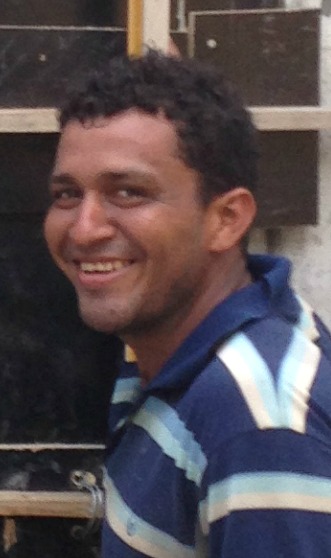
In fact, soon after our announcement our very first student began receiving one-on-one English conversation practice.
He appears to be advancing in his English speaking and listening proficiency at a very rapid rate. This student is highly motivated and also spends several hours each day listening to podcasts in English, as part of his self-created “English Immersion” program.
Obviously, we are still in the formulation phase of our project. We have no fixed structure in place. While we are still uncertain about the details, we are certain that there is a need for such a program. The best way to learn English is by being exposed to native English speakers.
If you are interested in participating in any way, please contact us.
Perhaps you have skills that could be useful to the program, even beyond simply tutoring in English. We are especially interested in talking with someone who is skillful in coordinating communication among the students and volunteers in the program. We are looking for volunteers to:
I am positive that I am not capable of all of the emails, texts, etc…that may be required, as the program gains momentum. However, I am available to participate in developing the process and introduce new tutors and students to the program. As the program grows, as I am sure it will, I may even be able to provide a physical space in Puerto Armuelles for holding classes, or one-on-one tutoring sessions.
Over the next year or so, it would be wonderful if we could offer English conversation opportunities to a 1 - 2 dozen motivated young people in Puerto Armuelles.
Hopefully, this program will help increase the English language proficiency in Puerto Armuelles. Fluency in English will certainly give these young people access to many opportunities in fast-developing Panama.
In recent months, we have talked with more expats who have plans to move to Panama, and Puerto Armuelles. Some of them already have a desire to help the young people of Puerto Armuelles. Many have also said they'd be interested in volunteering in the English tutoring program. Added to the longer-term expats in the area, we should be seeing a growing pool of potential volunteers.
Tutoring a young person from Puerto Armuelles in English is a great way to get involved in the community, in positive way, without making too big a commitment.
Not a Permanent Commitment
If you want want to volunteer, but don't want to commit, that is perfectly fine. You can assess as you go along. You can see if you would like to increase your participation, or back out if you discover you don't enjoy it. No worries or judgements. But for some expats, retiree or otherwise, this could be just the sort of adventure that they have been looking for.
An Exchange Program
We have also gotten requests for Spanish language lessons from local expats, particularly from retirees. For this reason, the idea of a “language exchange” program has emerged.
An exchange, or “intercambio” is a great way for an expat to share their own English language skills with a local youth. In exchange, the youth would help you to learn Spanish. This kind of program has been successful in many places. There is no reason that it couldn’t work for us here in Puerto Armuelles.
Please let us know if you are interested in participating in an intercambio.
Please let us know if you are interested or have any comments or suggestions.
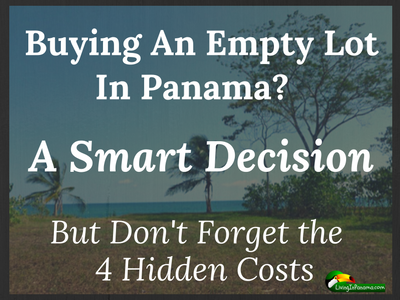
1) There is a lot of it. So there are many opportunities of buying the location you want at a price you can afford.
2) Vacant lots cost less. Somewhat surprisingly, even a lot with a structure that looks like it should be torn down, is priced higher than a similar lot with no structure. Check it out for yourself. There must be some psychological reason for this.
3) Investing in a vacant lot carries very low overhead costs---and there is usually very little maintenance required.
4) You get complete freedom to build & landscape the way you want. You decide where on the lot the house will be built, and what it will look like. You decide the look and feel of your property. If you have never gardened before, this is the place to get started. To cultivate many species, you simply get a cutting, stick it in the ground, and water. If you plant in the rainy season, you can skip the watering part. The term tropical paradise fits gardening perfectly here.
In Panama, you can buy a lot in the jungle with no infrastructure around --- not even a road --- or you might choose a lot in a sub-division, a place that has everything you need in place, ready and waiting for you to build your home.
More Remote = More Hidden Costs
Obviously, a lot that has everything ready to build your house will have no additional development costs. While a remote jungle lot could have very high development costs. Development costs are all the expenses necessary to get a site ready to start construction of a home.
Before you jump to the conclusion that an undeveloped lot is a screaming deal, you must factor in all the hidden costs. That is, how much will it really cost to get the property into “ready to build” condition.
The True Cost = Sales Price + 4 Hidden Cost Factors (described below)
You should calculate the true cost of a lot before you decide to buy. This is true even if you only plan to hold the property and sell it when it goes up in value. Most likely the person you eventually sell the property to will want to build on it. You need to make sure you are buying a lot that will be attractive and affordable to your future buyer.
Cost of the road or driveway will depend upon the lot’s
If you fall in love with a lot that is far from an access road, it will obviously cost a lot more to develop than if your lot is near, or on, an already established access road.
If the property is on a steep slope, that will open up whole new realm of hidden costs. Not only will the road cost a lot more and take more time, but you will have to deal with erosion and drainage issues. In a hilly area, you must take care to consider what to do with the water runoff so your new road won't be come a mud disaster. One key to a successful road is to put it in the dry season, not the wet season. After all the work of creating the road, you want it to stay usable for years to come not be washed out in the next big rain.
If you want to keep your road development costs down, or at zero, you should pick a lot that is
Google Earth - A Real Estate Tool
With Google Earth you can discover topographically challenging lots from the comfort of your computer. And you can use it to get a feel for the property before you visit it. Google Earth is free and can be used with both Apple and PC computers. To use it, you need to download the software and then search for your property by using its address or coordinates.
Now comes the fun part. You can zoom in using your mouse/curser and the command (control for PCs) and shift keys on your keyboard. Using the same controls, you can tilt the earth so you can see precisely where all the hills and valleys are on the lot and in the surrounding area. If you don’t know the lot's coordinates or address, you can usually find them using Google Maps (if you can locate the lot by sight), or by asking the seller for them.
Now that you can access the lot, you need to get it ready for constructing a house.
Ideally, your site is already level. Or it could simply mean removing some trees (just make sure to get a permit to do that) or adding a moderate amount of fill to level out the site.
If you are building on a slope, it will be more complicated. You may need a major earth building project including retaining walls and or drainage system.
Make sure you get a good ideas of the cost of these steps or it may come as an unwelcome surprise.
If you want to keep your site development costs down, or at zero, you should pick a lot that is
We have many affordable and beautiful lots. Almost all of our lots are ready to be built upon. No site or road development is needed. Many already have full utilities, or we offer to do that work at no extra charge. All are in the Puerto Armuelles area.
You can explore our properties by clicking here or using the property search tool at the top of the page.
Now on to getting utilities to your building site.
Generally, there is electricity available along all of the main roadways and neighborhood streets in Panama.
In Remote Areas
If you are buying a farm, or other remote property, you will be responsible for bringing in electrical power from the nearest road, where you will access it via overhead power lines. You will need to install your own power poles, or underground conduit, to access this power. And of course, you will need a licensed electrician to obtain an electrical permit, even if you are going to do your own electrical installation.
Alternatively, you can always decide to be completely off-grid. Just be sure to factor in the full cost of setting up and maintaining your own electrical system. Of course, if your lot is extremely remote you will have to go off-grid.
In Developed Areas (e.g., Puerto Armuelles)
In Puerto Armuelles, we generally have good access to power lines by our electrical utility provider (Union Fenosa). This makes electrical installation simple.
Once you start to build your house, you can connect the meter to the house in 2 ways. You can either hang an overhead line, which enters through the roof of your home, or you can install underground conduit, with the supply wires running inside. These wires connect the breaker panel to the electrical meter at the property line. From the breaker panel, you can do your own rough in wiring, or hire an electrician.
You can live without electricity, but not water. How will you get water to your lot and future house.
In Remote Areas
Before you buy a property in a remote area, make sure you know how you will get water to the site. It is likely that you are going to have to dig a well. If it is a well, check with an engineer to verify that you can actually build a well. Find out how deep a well you will need to dig. Then calculate the cost. If you are told there is a well there already, I suggest you check this out and test the water.
About Digging Wells
The good news about well digging in the rural areas around and as well as in Puerto Armuelles, is that it is very cheap. In most cases, wells are dug by hand, using a shovel. Our soil is silty/sandy, and it has no aggregates. (This is why it is not the most stable building substrate, and building footings should be deep and use plenty of steel reinforcement).
In short, a laborer digs your well, and then you line it with concrete pipe sections which are available in 4 foot lengths, and in many diameters from 10" to 2 or 3 meters.
Please be aware, hand digging is dangerous for the laborer. You should check with the municipal engineer to find out the details for doing this safely and if the person doing the work is covered by insurance. You can make it safer by having the hole supported, or "cribbed" during the excavation.
The pipe sections used to line the well are very heavy. You will need to schedule a back hoe to have them installed. You might just opt to use a back hoe for the entire well digging process, however the result will be quite sloppy. Back hoes cut a very wide hole. All that dirt will need to be stored on site until it is back filled. The dirt excavated for the actual well hole will need to be stored or used permanently either on site, or off site.
And, of course, you can also employ a well drilling company. There are some located in David. Just look them up on the Internet. I have not used a well drilling company yet. Obviously, this is the most expensive well digging option.
In Developed Areas (e.g., Puerto Armuelles)
In Puerto Armuelles (and other developed areas), most locations have access to the municipal water supply.
Hooking Up Water
To gain access to the municipal water supply, you simply cut in a connecting hub, or collar, into the ABS water line that runs alongside the street nearest your lot. In Puerto Armuelles, this ABS pipe is likely to be 3" in diameter.
You can buy a connection collar at most of the local building supply stores in Puerto Armuelles. You will need a permit both for the water supply line hook up and for any necessary street cut for the new pipe. You will only need a street cut permit if the city water line happens to be located on the opposite side of the street from your property. This street cut is performed by MOP (Ministry of Public Works).
I am fairly certain that you can apply for your own permit. However, for the $20 that my plumber charges to do all the legwork of obtaining permits, I never get my own permits. At all costs, I try to avoid waiting in lines at all of the various municipal offices. I don't have the patience.
Service & Expense
Generally our water service is good. The water is abundant and cheap. Our bill is under $5.00/month for unlimited use.
Interruptions in Supply
Many locations in Panama, including Puerto Armuelles, still experience occasional water shortages. In our area, these are not actual shortages, but rather interruptions to service. Water service is temporally shutoff due to a highway building project, or occasionally, storm related damage to a water supply pipe during heavy rains. Such interruptions are becoming less and less frequent. This is certainly not a chronic problem anymore, not the way it was 10 years ago. In addition, the water to our neighborhood is shut off in the afternoon everyday. I have never been clear about exactly why this is done. But it is the reason almost every house in our neighborhood has its own water tank.
Install A Water Tank
It is never convenient to be without fresh water, even for a few hours. The easiest way to overcome this is to have your own water storage tank located on your property. That way, you won't even notice when the municipal water supply is shut down for an hour, or even an entire day. You will have your own backup supply on your property.
At our house in the Las Palmas neighborhood we have a 140 gallon emergency tank. It is raised up on a platform about 12 feet above ground. It fills whenever there is city water pressure. When the municipal water fails due to road work, which has been pretty common with the new highway construction, or due to the new water and sewer system being installed in Puerto, we are covered. We also use it everyday as the source of our water after the city water is mysteriously turned off for the day. We have a gravity feed from this elevated tank directly to the house---we don’t use a pump. It has been years, since we were absolutely “out of water”.
Water Drinkability
Generally, water is drinkable in Panama. Bocas del Toro is the only blanket exception to this rule. In addition, at times, Panama City has issues with its water quality.
But again, overall, Panama's water is perfectly drinkable. Much more so than some areas of the US (not even including Flint, Michigan). My daughter still reminds me of how truly horrible the water is in the elegant neighborhood of Washington D.C. where her grandparents live. My parents happily drink that water. They are used to it. My children considered it to be unfit for human consumption.
Although the water in our town is drinkable, most expats and many Panamanians filter or buy bottled water. Many people (like us) get bottled water delivered to their home. Some people are concerned about water quality, but many people do it for aesthetic reasons. In the rainiest times of the rainy season, the water from the tap can look cloudy. That is what prompted us to start drinking bottled water. We always use tap water for cooking, but for drinking we use bottled water. At least we do at home, when we go out we happily drink the tap water.
You must include the cost of taking care of all the outflow from your home as well. How you take care of this depends upon where your lot is located.
Out of Town & Remote Areas
Sewer service is only available right in town, or along the main roads. If you are not in town, or on a main road, you will need to invest in a septic tank.
You are supposed to get a permit for most plumbing projects, including a septic tank. This application must be submitted by a licensed plumber, even if this plumber is not going to do the work. Talk to your neighbors to learn more about how this septic tank permit & installation process is usually done in your area.
Installation of Septic Tanks
There are a variety of methods for installing a septic system. The very poorest people in Puerto Armuelles simply dig a deep well, line it with old car tires, and run their pvc waste line into it (or put an outhouse on top).
Most locals who can afford it, build 2 separate septic tanks out of concrete block.
The 1st one, in line from the house, captures the solids and lets the liquid flow off the top toward a secondary tank. This 2nd tank is filled with large round drainage rock. (This rock is available from local rivers. It can be delivered to your building site by local truck operators.)
This 2nd tank provides a drainage “field” which leaches out into the surrounding soil, and hopefully, filters out all dangerous bacteria, before flowing to a nearby stream, or the ocean.
You can also purchase black plastic (ABS) molded tanks from local building materials suppliers, or from suppliers in David. Most suppliers in David offer delivery services to Puerto.
In Town - Sewer Connection
If your lot is in town, or off a major road, you can hook up to the municipal sewer system. To connect to the municipal sewer pipe on your street, again, you must apply for a permit. Again, this application must be filed for by a licensed plumber, even if this plumber is not going to do the work.
The connection is a simple matter of cutting in a connecting hub to the municipal sewer line, usually 6” pvc pipe. Generally, homeowners connect their own 4” pvc pipe to this 6” pvc pipe. It is a simple procedure. Pipes are not buried very deeply. Generally not over 3 or 4 feet. Given that our soil is silty/sandy, this kind of work can usually done with a couple of laborers with hand shovels in half a day.
The entire connection process, including plumbing and backfill, shouldn’t take more than a day. That is, after you have the permit in hand.
Before you buy a lot, you should estimate the cost of permits, materials, and labor to get utilities to your building site.
Obviously, if all your utilities are already delivered to your lot, you will be saving both money and headaches. If your lot is in a remote area, your "get your site ready" development costs will be a significant part of the true cost of your lot. Also, don't forget to factor in the amount of time it will take to get all that infrastructure into place.
The bottom line: Is the lot worth the price?
To know that, you first need to know the true cost of the lot. True price = Sales Price + 4 Hidden Cost Factors
Which Is The Better Buy?
Calculating the true price eliminates many unexpected expenses. It also allows you to knowledgeably compare seemingly diverse properties. For example, knowing the true cost of properties allows you to know which of these similarly sized and located lots is a better buy:
Hopefully, you now have a better understanding of what it means to buy an empty lot. As we explained, depending upon the lots location, getting an empty lot ready to build upon can be very easy or very challenging process.
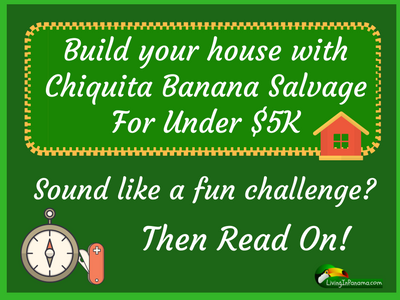
“When I grow up,” Paul proclaimed, “I am going to build myself a house out of trash”.
(FYI - He never did build a house of trash. He teaches painting at Penn State)
I certainly wasn’t interested in living in a house made out of trash. It sounded kind of, well, trashy.
That was in 1979.
Fast forward 30 years, and nobody calls it “trash” any more.
Today we use the terms “recycled material” or “Post Consumer” material. We’re all building out of recycled materials, whether we realize it or not.
The fact is that many parts of our homes are made out of “trash” today. Thank goodness for recycling.
With 7 billion people living on the earth, and with the continued promotion of the “American Dream” (ie, a high consumption, high environmental cost, standard of living) there is going to be an ever greater need to get creative about using recyclables in home construction.
In Seattle, where our family is from, many creative remodelers and builders visit the Boeing Aviation Surplus Store to find such crazy building products as aluminum honeycomb fusilage, or solid aluminum bar stock “I-Beams”, and you name it. It’s pretty high tech stuff, but it appeals to a certain type of designer builder.
For instance, on an loft apartment/art studio project in which I participated, our crew used aluminum honeycomb panel fuselage material as the floor in a sleeping loft. Aside from being super cool to look at, since the hexagonal cells of the honeycomb were visible on the exterior sheet surface, the material was so rigid that it required no structural supports, other than the perimeter walls. Obviously this material calls for a different approach to building (ie, practically no framing support). This results in a very clean, ultra modern look. It wasn’t a look that I particularly liked for a human dwelling. It wasn’t traditional, cozy, or “homey”. Rather, it was “defiant”, “impervious”, “edgy”. It certainly challenged the viewer’s normal sense of what constitutes a home.
Of course, you can also find much more traditional recycled building materials in Seattle. There are many, many recycled building supply centers in Seattle, as there are in most metropolitan areas of North America. You can find old fir warehouse beams, recycled bowling ally floors, stained glass from old churches, antique bar mirrors and surrounds from 120 year old hotels.
When one comes to Panama, one doesn’t think about recycling. Most buildings are pretty new and made of cement.
However, Puerto Armuelles is unique here. What we have is a company town, former home of Chiquita Banana Company. “The Company” as it was known, imported most of the materials used to build the town of Puerto Armuelles, literally from the ground up.
If you have ever get the chance to explore inside an old Chiquita Banana house, up on stilts, you will surely discover lumber stamps from Portland, Oregon where this gorgeous, old-growth red cedar was milled well over half a century ago.
If you know anything about lumber, then you also know that the quality of the 2”x4”, 2”x6, 2”x8” framing material, as well as the 8”x8” and 8”x 10” support posts and beams is of such standard that has not been available as building material in North America for decades.
If one purchased it in the states today, the wood in the old Chiquita Banana Houses would be considered “furniture grade” and probably cost in the $15-$25 range per board foot—prohibitive for home building. I wouldn’t be surprised if our own house in Las Palmas contained over $50k worth of clear, old growth cedar.
If you look at the tightness of the growth rings, you will see that none of these trees could have been younger than 1000 years old. I love this beautiful old wood. Still, I’d much rather see the wood in the forest than in my house.
In addition to clear, old growth cedar, some of the more recent vintage Chiquita Banana Houses are built using the identical plan as the original Chiquita houses.
However, the newer models, dating from 25, 35, even forty years ago, are built from other exquisite woods. That is, these houses are built of dimensional lumber logged directly from the jungles (now, former jungles) of our own Punta Burica.
Just as the original Chiquita houses were built of ancient Cedar trees, so the newer generations of Chiquita houses are built of local, but equally ancient forest trees. Species such as Teak, Sangrio, Espave, Kirra, etc. A couple of these woods, particularly teak have very good resistance to termites. Sangrio and Kirra are gorgeous furniture quality hardwoods that are really too hard to be good framing material. They require pre-drilling, prior to sinking a nail.
As for the logic of cutting down a 10 foot diameter ancient rain forest tree in our local jungle just to make an 8”x8” structural post or beam in a Banana Company house, some of us have different views. I suppose back in the days of Chiquita Banana in Puerto Armuelles, nobody ever thought that the world would ever run out of wood. If you are from Canada, it might seem that there is still an endless supply of old growth trees.
I am not suggesting that one purchase Chiquita Banana houses and begin disassembling them and loading them into containers for export. But, rather, I am saying that there is a huge quantity of amazing building material available for those who are on a tight budget, but who have creative energy to burn.
Many of the original Chiquita Banana houses have fallen into disrepair. Since the local builders have a strong preference for building with concrete, many of these Chiquita houses just get scrapped, or used as concrete form boards.
A thorough search in the various neighborhoods of Puerto Armuelles would surely turn up some excellent salvage. I am guessing that one could purchase adequate salvage material from old Chiquita Banana houses to build an amazing beach house, for a couple to 5 thousand dollars.
This includes studs, joists, cedar siding, and super heavy duty galvanized roofing. There are still even a few old Chiquita hand washing sinks and toilets floating around in town.
I do not want to contradict what I said earlier about wood not being a desirable building material in our coastal/tropical climate. I stand by that opinion, if you are building a conventional house, using conventional methods and utilizing the labor force available in Puerto Armuelles at the present time.
Find out more, by reading why you shouldn't build with wood in Panama and why remodeling a wood home is not the best idea.
However, if you are artistic, high energy, and want to build something super inexpensive, something that is truly unique, and truly yours, building with Chiquita salvage could be ideal.
I think you might be able to come to Puerto Armuelles, buy a bargain priced lot for under $5k, and put up a completed structure, made primarily of recycled Chiquita Banana surplus.
The final product would be limited only by your own skill and imagination. This entire home could be built for well under $5k (total price for house and land under $10k).
Obviously, this sort of a challenge, and this kind of lifestyle, is not for everyone. However, if this sort of thing sounds like a fun adventure to you, you have come to the right place. Puerto Armuelles is a great place to experience this sort of an “alternative” eco- building lifestyle.
I have only mentioned Chiquita wood salvage so far, but Chiquita Banana imported other great materials as well. For instance, you will notice shortly after arriving in Puerto Armuelles, that many of the local fence posts are made from railroad rail, salvaged (stolen?) from the narrow gauge Chiquita Banana railroad tracks.
These tracks ran from the banana fields all the way to the shipping pier in downtown Puerto Armuelles. The train also ran to David. Some folks have reused this rail to build house posts, beams, storage buildings, hoists, racks, etc…
Imagine a practically unlimited supply of railroad rail. If this starts your mind thinking of possible projects, then you are the person I was hoping to communicate with in this article.
In addition to railroad rail, Chiquita imported miles of steel plumbing pipe, as well as some super thick walled steel tube section, both round and square.
Some of this material is still being sold just for its scrap iron weight. However, the salvage market is certainly getting more competitive, as materials prices go up. However, it depends on how good a scavenger you are.
If I could show some of this Chiquita Banana salvage to my friends from architecture school, they would probably have heart attacks. All this salvage, and very few people who have the design skill to take advantage of it.
If you have any questions about recycled Chiquita Banana building products, or about alternative building methods, in general, please contact us. We are always happy to share with you what we know, and we are eager to learn anything that you might be willing to share

Thurs, September 8, 2016
A crowd of Portenos had assembled to hear him speak.

Puerto Armuelles will have an all new hospital. The new facility will include:
It will happen in 3 phases.
But while the new hospital project is a positive backdrop for President Varela’s visit, the crowd gathered were more interested in knowing:
“What are you going to do to boost our local economy here in Puerto Armuelles?”
Residents of Puerto Armuelles are somewhat skeptical of the promises of President Varela, as they were of previous presidents. After Chiquita Banana left Puerto Armuelles, now about 15 years ago, presidential administrations have all promised projects to bring economic vitality to Puerto Armuelles.
Today, President Varela explained that he is fulfilling his promises to Puerto Armuelles residents.
First of all, the current negotiations with Del Monte to take over the Chiquita Banana plantations are almost complete. (These negotiations have been in process for over a year.) The President has signed the final executive approval for Del Monte to begin work. All that remains is the final approval by the legislature. (Find out more about the Del Monte banana deal here).
President Varela anticipates that the deal will be passed by the legislature in the near future. He predicts that Del Monte will start operations in early 2017.
The Panama government has negotiated with a few other banana companies (including Chiquita) since Chiquita left Puerto. But none, have gotten as far into the process as Del Monte.
Del Monte will employ up to 3,000 workers in Puerto Armuelles.
I'm sure Del Monte taking over the banana plantations will contribute to the current upswing in prosperity in Puerto Armuelles. The renaissance of the “Green Gold” can only be good for Puerto. (Green Gold was the a name used for bananas during Chiquita's reign of Puerto Armuelles.)
In addition to President Varela’s announcement about the imminent arrival of Del Monte, the president also touched on the continued investment in the new, 4 lane highway into Puerto Armuelles.
Road out to Limones
Varela stated that he had approved the funds to continue this new highway all the way out to the fishing community of Limones. Limones is 12 kilometers past Puerto Armuelles, on the Punta Burica Peninsula.
Over the last decade, the road to Limones has been upgraded several times. But the work has always fallen short of a long lasting and paved road. All past work on the road, has been partial at best and it has always fallen into disrepair very quickly.
This time, President Varela said, the work is going to be done right.
The President stated that, with these and other positive investments, the Puerto Armuelles community will continue to reap the benefits of the higher quality of life so much of Panama is enjoying.